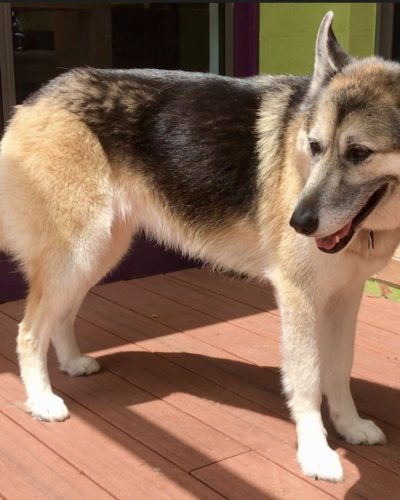Canine Cognitive Dysfunction
Behaviour problems in older dogs are not necessarily alarming. But in some cases, they can indicate hidden medical problems and age-related cognitive decline. Since such a condition can seriously impair a dog’s quality of life, early detection and access to treatment or symptom relief can be crucial in prolonging your pet’s life.
What Is Canine Cognitive Dysfunction?

Cognitive functions include mental processes such as awareness, perception, learning and memorising. The brain must process acquired information captured through their sensory system; this cognitive process enables the dog to make conscious and unconscious decisions about the environment and adjust their reactions accordingly.
Canine cognitive dysfunction syndrome (CDS or CCD) is a neurobehavioural disorder that affects the ability of dogs to use these mental processes, which causes a behaviour change. This age-related decline in cognitive abilities affects the general functioning of a dog and its reactions to the environment.
In an article published in 2019 in the National Library of Medicine, a group of authors researched the areas that are most often affected when a dog's cognitive function declines. They found that the condition was associated with disorientation, altered interactions with owners, other pets and the environment, sleep-wake cycle disturbance, house-soiling and changes in activity. Concluding that CDS in dogs is comparable to dementia in humans.
Prevalence of Cognitive Dysfunction in Dogs?
The prevalence of CDS in dogs is higher the older the dog is. In dogs aged 11-12 years, the prevalence is around 28%; dogs aged 14 years have a 48% chance of developing this disease, while dogs older than 16 years suffer from CDS in 68% of cases.
Today, dogs enjoy long lives thanks to the excellent care of their owners, who provide a balanced diet, regular training, health check-ups and social interactions. This extended life expectancy in dogs also increases the risk of developing diseases associated with old age, including CDS.
Causes of Canine Cognitive Dysfunction?
Like humans, dogs go through significant changes during the aging process. Some changes are visible on a dog's body, while others occur under the surface, in the deep interconnections within the body. Significant changes, however, occur within the brain structure and function, which can influence the development of cognitive issues, including CDS.
Brain Atrophy

Over time, brain weight and size slowly decrease. This process is particularly noticeable in the area of the cerebral cortex (the centre of learning abilities, memory, personality and information processing), basal ganglia (the centre for learning, cognition and emotion) and cerebellar cortex (balance and coordination centre).
These areas of the brain are essential in expressing personality and outward behaviour. The structural changes associated with aging, directly affect the functionality of the central nervous system, leading to changes in behaviour, and can also cause tremors or movement problems.
However, some of these symptoms associated with CDS can also present in other conditions. So it is essential to seek comprehensive veterinarian care if your dog is displaying any unusual symptoms or is acting differently.
Accumulation of ß Amyloid Protein
The accumulation of ß amyloid protein is seen in people suffering from Alzheimer's disease, it is assumed that this protein occurs due to small clots and microscopic hemorrhages that prevent proper blood flow and cause accumulation.
The same abnormal amount of build-up of ß amyloid protein can occur in the dog's brain, leading to reduced brain activity, loss of neurons, damage to signalling pathways, and altered numbers of neurotransmitters. All of which are essential parts of the nervous system.
Neurotransmitter and Other Brain Chemical Changes
Dogs with CDS usually have a lower amount of dopamine in their body. Dopamine is a dual-action hormone and neurotransmitter that plays an essential role in movement, memory and motivation—impacting the ability to concentrate and react.
This condition occurs because the activity of monoamine oxidase B (MAOB), a molecule that breaks down the neurotransmitter dopamine, is increased in the body of a dog suffering from CDS.
Additionally, the levels of other molecules and neurotransmitters in the dog's brain change as the dog ages, so this is another factor that can contribute to the development of CDS.
Physical Signs of Cognitive Dysfunction

A diagnosis of Canine Cognitive Dysfunction is often delayed because owners believe that the behavioural changes are associated with normal aging and put off seeking treatment.
In dogs with CDS, they often exhibit signs of physical disturbances such as a change in gait, or posture disorders and a decline in perception. In some cases, there is also a reduction or loss of vision, but this area has yet to be researched and the link confirmed.
Clinical Signs of Cognitive Decline
Older dogs, termed "geriatric", should have a regular check-up with their vet. In addition to a physical examination, these check-ups should include questions about possible disorientation, interactions with people and other animals, sleep-wake cycles, social interactions, soiling in the house, activity level, and nutrition.
Older dogs show a decline in exploratory behaviour, and their interaction with people often decreases. Some owners report a phenomenon whereby their dog repeatedly looks in a mirror, suggesting a deficit in habituation to the reflection of their own image.
Signs that are associated with CDS, and warrant a trip to your vet include the following:
Anxiety
Anxiety may be expressed through Increased panting and pacing, the inability of the dog to calm down and relax, the appearance of recently acquired separation anxiety, and sensitivity to sounds.
Disengagement
Older dogs may appear more disengaged, with a decreased interest in their owner and family with whom the dog lives. They may spend an increased amount of time sleeping or refuse to play; more generally, they will have a reduced amount of activity.
Pacing
Pacing, in this sense, refers to repetitive walking in circles or walking around the house aimlessly. The dog may appear uncomfortable or restless.
Disorientation
With impaired cognitive functions comes the loss of navigational skills, the dog may have difficulties remembering how to get from one part of the house to another. Furniture suddenly becomes an obstacle, and the animal doesn't know how to get around it, they may forget where the food bowl is or where the door to leave the house is.
House Soiling
The sudden or gradual loss of toileting skills is always a red flag for prompt veterinarian care. For dogs who are potty trained and are now having accidents in the house, it is likely associated with health rather than behaviour. Treat your dog kindly if this happens.
Changes in sleep rhythm
When the sleep-wake cycles have become distorted, and the dog cannot calm down at night, and cannot sleep, they may often roam around.
The Canine Dementia Scale

To determine the severity of CCD, whether it's a mild cognitive impairment or severe, a scale was defined—the Canine Dementia Scale or CADES. It is a highly sensitive rating scale for dogs that are suspected of suffering from CDS or the development of the disease is being monitored in already diagnosed pets.
The scale consists of 17 non-redundant items spanning four relevant domains: spatial orientation, social interactions, sleep-wake cycles, and house soiling. In the most severe cases, impairment is displayed in all four domains.
Diagnosis
Only a licensed Veterinarian can diagnose medical conditions. So if you are concerned about your dog having this condition, book an appointment with your regular vet. However, the diagnosis of CDS may not be straightforward; this disease often goes unnoticed by handlers, with symptoms explained as signs of normal dog aging.
Many other medical conditions have similar symptoms, so even veterinarians can make a mistake in the diagnosis, and the fact that there is no single test that would unequivocally confirm or eliminate suspicions makes it even more difficult. Therefore, the diagnosis is carried out by observing symptoms and lab tests that eliminate the presence of some other disease in the body.
History taking
Your vet will likely start the examination by asking about your dog's medical history. Therefore, as a pet parent, be prepared to clarify situations such as your dog's eating habits, current medications and/or supplements, changes in your home or the immediate environment that could affect the dog, open signs of illness such as vomiting or diarrhea, changes in behaviour, sudden or gradual.
If your dog shows changes in behaviour at home, prepare for the appointment by creating a timeline of how the changes occurred and progressed. You can also take a video with you, which will be the easiest way to show the veterinarian what behaviour problem you and your dog are facing.
Medical tests for CCD in dogs
Your veterinarian may perform additional tests to eliminate diseases with symptoms similar to CDS. These are usually a complete blood count (to eliminate the possibility of infection or anemia), blood chemistry (to detect liver, kidney, diabetes, etc.), urine analysis (to detect infections in the urinary tract), and other tests such as X-rays, CT scans or MRIs.
Prevention

Although it is not possible to prevent the disease, keeping older dogs fit and generally healthy ensures their bodies are best able to cope. Maintaining good nutrition, mental stimulation, good posture and movement patterns throughout their lives is key to leading a happy, healthy life.
Treatment
There is no cure, but effective management of CDS usually includes environmental and behavioural interventions, dietary interventions, food supplements, and complementary therapies. If it is necessary, your vet will also be able to prescribe medications to help relieve symptoms.
Enrichment and Environmental Management
Changes in the environment may be necessary to meet the new needs of your pet and increase comfort. For example, going out more during the day or placing the litterbox in a location easily accessible to the dog. It may be necessary to move the dog's bed to a quieter part of the house, away from the noise and daily activities of the household.
It may also be necessary to adjust the way of communication with a dog suffering from CDS and use more powerful motivators for exercise and learning, especially high-value food rewards. Routine is crucial, as it will help the dog to reduce anxiety, while regular mental and physical stimulation will help your dog's cognitive and physical abilities to remain functional as long as possible.
Nutritional Intervention
Dietary treatment of CDS is primarily aimed at reducing the harmful effects of toxic free radicals. Cognitive improvements have been documented in older dogs fed an antioxidant-rich diet containing flaxseed, carrots, spinach, citrus pulp, tomato pomace, grape pomace, and foods containing mitochondrial cofactors, phosphatidylserine, and omega-3 fatty acids. All these have proven beneficial for geriatric patients.
When it comes to dietary supplements, the glucose lipid dietary supplement has shown great success in reducing the level of Aβ deposits and improving mitochondrial function.
Supplements can also compensate for the lack of phosphatidylserine, a natural phospholipid that facilitates membrane-dependent neuronal processes, enhances acetylcholine release, inhibits loss of muscarinic receptors, activates synthesis and release of dopamine, and may improve memory, learning, and social behaviour.
Supplements such as Antinol Rapid can be safely added to your dog's diet.
Complementary Therapies
Older dogs often struggle with anxiety-related conditions. Symptoms of canine anxiety can often be helped with canine complementary therapies, gentle, non-invasive, therapeutic treatments that advocate for a holistic approach, can help.
These are, for example, aromatherapy, herbal supplements, acupuncture, massage or manual therapy. At Canine Body Balance, we offer Canine Osteopathic, Canine Bowen Therapy treatments and Whole Energy Body Balance that gently approaches dog relaxation on physical, mental, and emotional levels. Inquire or book a session with us.
Life Expectancy of Dogs With CDS
As with people suffering from dementia, it is difficult to determine the life expectancy of dogs suffering from CDS. If the dog is otherwise healthy, CDS will gradually impair its quality of life, but it is difficult to determine how quickly this might happen. It is best to monitor your dog regularly, consult with the veterinarian, and describe any changes you notice. This will help your dog to spend its old days happily and contentedly.
Make a bucket list of all the things your dog loves to do, and try to incorporate one of their favourite things each day.





Leave a comment